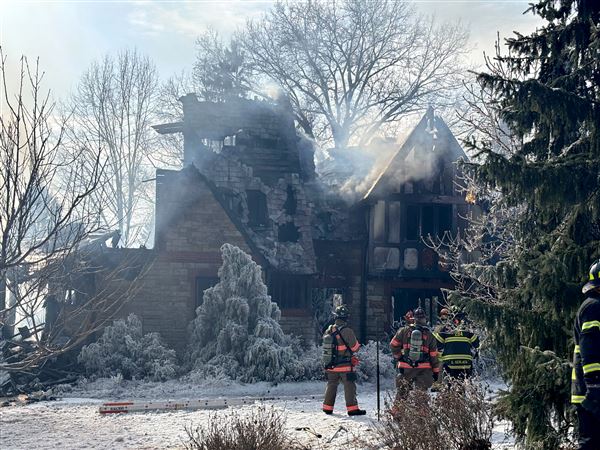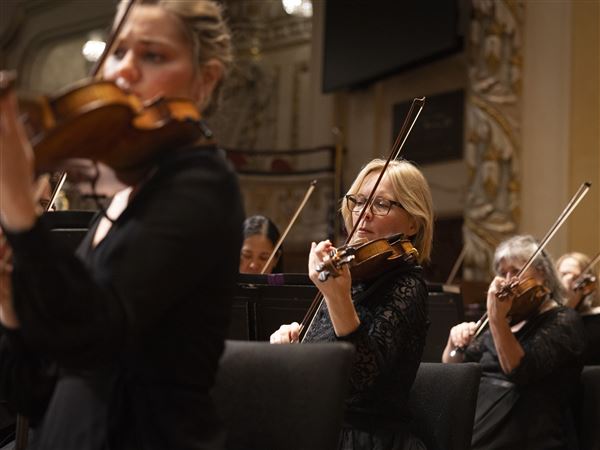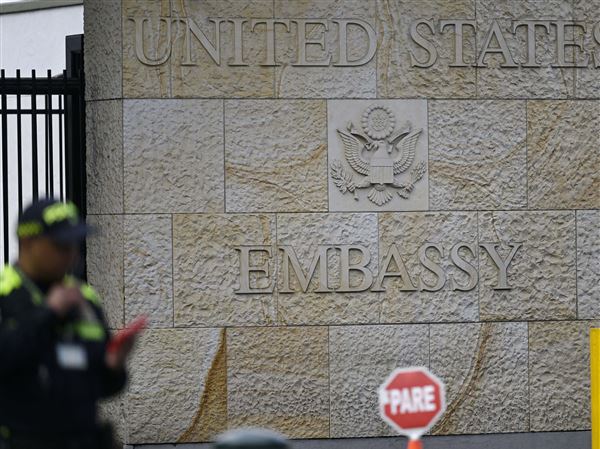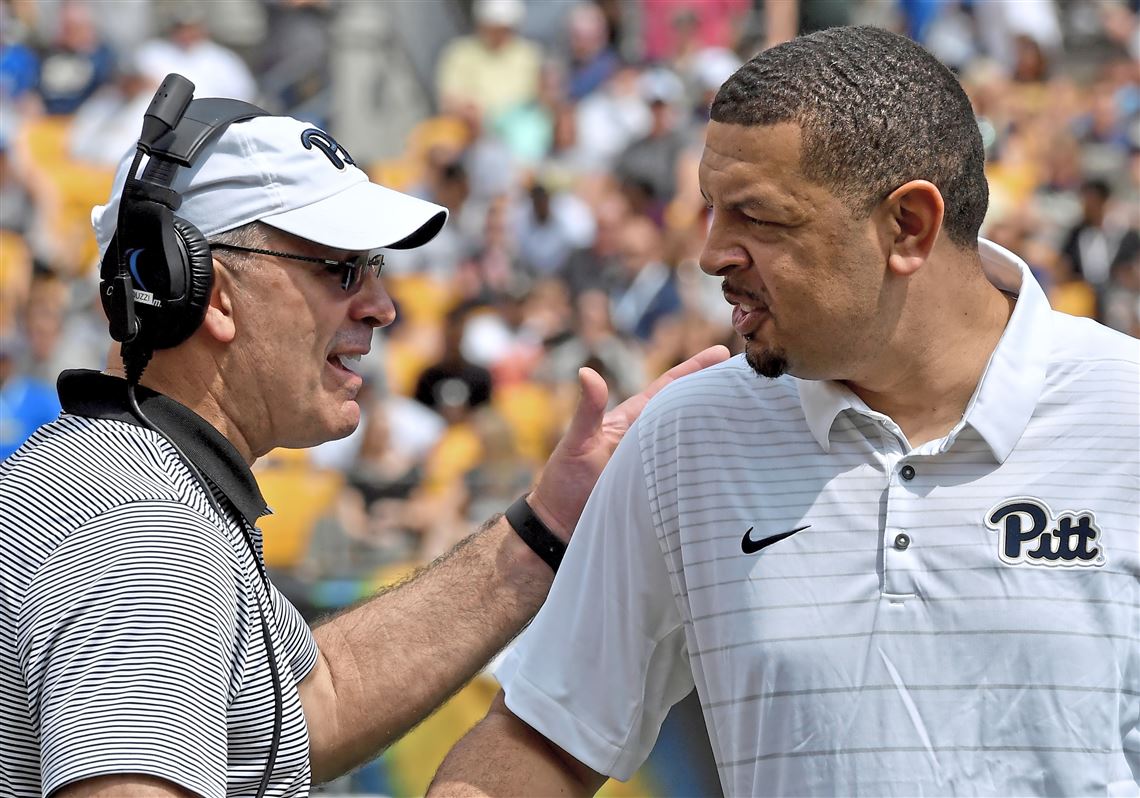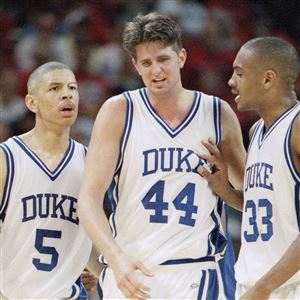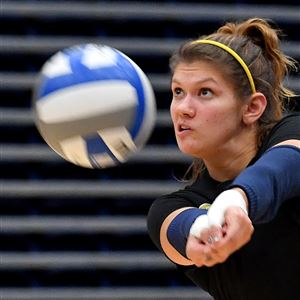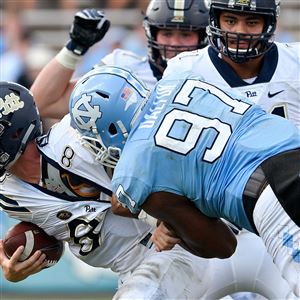(This is Part II of our three-part series. Part I can be found here. Part III can be found here.)
Heather Lyke says her staff doesn’t like hearing this story, but she tells it anyway. It was around the time she arrived as Pitt’s athletic director, and reality was setting in about how little her new school had accomplished since joining the Atlantic Coast Conference in 2013.
“I heard this rumbling, like, ‘Well, we never really prepared to be in the ACC,’ ” Lyke was warned. “And I’m like, ‘What do you mean we weren’t prepared? We’re going into our fifth year in the ACC.’ And they said, ‘Well, we just haven’t had that much success.’ ”
And yet, Lyke thinks a lot about trophies. That symbolic hardware comes to mind when she discusses where she intends to lead Pitt, as well as when she reflects on where it has been, feeling its way out through a foreign league in which meaningful victories have still proven to be elusive a half-decade later.
When she was hired in March 2017, through nearly four seasons of ACC play for all of Pitt’s 19 programs, there was only one team championship, a regular-season title for the wrestling team. Looking to seize on that beacon of hope, Lyke asked her employees where the trophy is, and — to her bewilderment — no one knew.
So she set out to find it, exploring storage closets and locker rooms in Fitzgerald Field House — the home of the wrestling team that was built in 1951, she’s sure to add. Eventually, down two flights of stairs at the very bottom of the building, there was a small video room with a small table, a couch and two end tables. On one of those tables sat that out-of-sight, out-of-mind token of ACC triumph.
“So what are we gonna do with the second ACC championship trophy,” Lyke set up her punchline at a charity event this summer, “put it on the other end table?”
Since that revelation for Lyke — who called her current school’s standing in the ACC “average, if at best” — Pitt has now won conference title No. 2, a regular-season championship that the women’s volleyball team shared with Louisville in 2017. But never mind an end table: So far, Pitt’s on-field and on-court success in the ACC could fit in a thimble.
‘We’ve got to raise the game’
New men’s basketball coach Jeff Capel has heard the complaint that comes up most often about the once-proud program he inherited: The Panthers don’t fit the ACC’s style, and that’s part of the reason the beast Jamie Dixon built in the Big East couldn’t be sustained.
“I don't know why the dip happened. I wasn’t here, so I don’t know. That’s for people to pontificate on to figure that out,” Capel said a few months after taking the job, then pointed to a couple examples to disprove that theory. “Notre Dame has been able to have success in both. I think Louisville’s had success in both.”
That, in a nutshell, explains why Pitt’s first five years in the ACC are worth exploring at all. It hasn’t led to much winning — and more losing than its final five years in the Big East — but there’s no clear explanation as to why. In the short term, it doesn’t help that Pitt has changed athletic directors twice and hired 13 new head coaches since changing leagues; it’s probably no coincidence that Pitt’s second-longest-tenured coach, Dan Fisher, heads up the school’s highest-ranked program, women’s volleyball. And even Fisher has only been here since 2013.
Before fall 2018, and counting Pitt’s 10 programs that compete in sports with the traditional win-loss column (football, men’s and women’s basketball, baseball, softball, men’s and women’s soccer, tennis, women’s volleyball and wrestling), the Panthers won 48.6 percent of their games and matches since entering the ACC. That winning percentage dips to .354 in-conference, with men’s teams winning at a .351 clip and women’s teams combining for a .356 mark in their first five seasons against ACC foes.
Pitt athletics wasn’t exactly the gold standard of winning in the Big East, either, but men’s teams were winning 62 percent of their contests over their final five seasons and women’s teams 50.1 percent. The Panthers were much more competitive among Big East opponents, especially the men sporting a .582 winning percentage and women at .419. Overall, Pitt’s men’s and women’s teams enjoyed a victory 55.4 percent of the time overall and 49.7 percent in Big East action from 2008-13 before officially jumping to the ACC July 1, 2013.
“I think Pitt has been what we expected Pitt to be,” longtime ACC commissioner John Swofford told the Pittsburgh Post-Gazette last month. “I doubt that the major programs have reached their potential, competitively, within the league.”
The powers that be should hope not.
In its final five years before the ACC leap, Pitt won its conference five times: Men’s basketball secured a regular-season title and football shared one in the Big East, while the Panthers won the Eastern Wrestling League three years running from 2010-12. Of the ACC’s 15 universities, Pitt has the second-fewest conference championships with two, ahead of only Boston College’s one. And even those two were that one regular-season wrestling title, in a year Pitt didn’t win the ACC championship meet, and the women’s volleyball title that was shared with Louisville (there is no ACC tournament). But Boston College has twice won the ACC Atlantic Division in football, and while that might not count as a conference title, you can bet Pitt will throw a party if or when its program wins the Coastal. Sure, Pitt’s only been in the conference for five years, but so has Syracuse, and it has three regular-season team titles and 10 tournament championships. Louisville joined the year after Pitt and Syracuse but has three.
North Carolina, the grand poobah of ACC programs, easily boasts the most jewelry, with 275 team crowns.
“I think at one time, it was like, ‘OK, football’s got to be good. Basketball’s got to be good,’ ” Lyke said. “And now we have our other 16, 17 sports that we’ve got to raise the game.”
Adjustment to the elite
Beyond the big-money sports of football and basketball, whose moves to the ACC have been scrutinized over and over from various angles in the past five years, Pitt’s other sports have been even more of an afterthought than they would be if they were winning.
That 0-18 conference record for men’s basketball last season under Kevin Stallings? Well, that’s nothing compared to men’s soccer, which hadn’t won an ACC match until earning two victories last year. Women’s soccer has had two winless conference campaigns, and women’s tennis four, with just one ACC regular-season triumph and one ACC tournament win in program history. Those three teams all went winless in their first ACC seasons, and to hear former men’s soccer coach Joe Luxbacher recall the transition, his Panthers might as well have been strapped to a board waiting to be fed into a buzzsaw, considering they were coming off an 0-8 season their last year in the Big East. At that time, the ACC might have been the only league tougher.
“When they tore down Pitt Stadium, we didn’t have a practice facility or a home field on campus,” remembered Luxbacher, who retired in 2015 after a 32-year tenure that ended with four consecutive winless conference seasons. “For years, we had to go to [Founders Field] out off Route 28, near Harmarville. That gradually erodes recruiting. I think that hurt big time.”
But Luxbacher’s program was one that had fallen on hard times for years, and, frankly, wouldn’t move the meter much for Pitt fans either way. The teams that now belong to Capel and head football coach Pat Narduzzi are the cash cows, the points of pride more than anything else Lyke presides over, and both programs are far from their glory days.
While men’s soccer and women’s tennis have by far been Pitt’s worst-performing squads in the ACC, the revenue giants have slipped, too. Football was 22-13 (39-26 overall) in its final five years in the Big East but started 21-19 (34-30) in the ACC entering this season. Men’s basketball fell even further, going from 60-30 (130-46) to 32-58 (90-78) in the same span.
By comparison, Syracuse couldn’t get much worse in football, but has. In men’s basketball, though, the Orange is still winning slightly more than 55 percent of its games. Like Pitt, the Syracuse athletic department also has seen its 10 team sports have less success since changing leagues (.658 win percentage to .585 overall, .581 to .383 in conference play). In football, Pitt’s realignment contemporaries Cincinnati, Connecticut, Maryland, Rutgers and West Virginia all saw at least minor slippage conference-to-conference from their last five years to first five, whereas Cincinnati and Maryland were the only ones to see their conference records improve in men’s basketball.
That data would seem to suggest there is something inherently challenging about adapting to a change of scenery, whether that’s new travel, unfamiliar opponents, or — in any sport — a vastly different collective style from one league to another.
“I thought the Big Ten was it, and that there wasn’t better football than that — I really did,” Narduzzi, a former Michigan State defensive coordinator, said at ACC media day in July. “Then we come to the ACC, and it’s better football. You sit there and think about it, everyone talks about all the athletes down South; when you look at the ACC conference, it’s north to south. It’s Miami to Boston, and Syracuse, and it’s a different type of athlete than you’re getting in the Midwest. … It’s a different speed. I think the ACC speed, overall, is better than the Big Ten. Eight years in one conference and now three here, it’s different.”
Luxbacher coached what most people around the world consider football, rather than the American version, but he wouldn’t disagree with Narduzzi’s statement. He also wouldn’t necessarily agree with Lyke’s anecdote about Pitt being ill-equipped for the move.
“That’s hard to say. I don’t want to pass the buck,” Luxbacher said. “I think there are good coaches at Pitt, and they did their best. You don’t want to throw it on the coaches or the administration not being prepared. I just think it was a lot of difference from the Big East.
“I know the coaches all tried their best, but I do think when you’re playing in an elite league like the ACC, recruiting — you still have to coach them up, don’t get me wrong, but you can’t pass or dribble or shoot for them. You have to recruit top guys, guys that can compete at that level, and we’re talking a level right below professional.”
Great expectations
While football toils as a middle-of-the-pack team, women’s volleyball — Pitt’s only team to improve its conference record as an ACC member — has established itself as Pitt’s only dominant athletic program under sixth-year coach Dan Fisher, at least among its league peers. Men’s and women’s soccer appear to be on paths to consistency with recently hired veteran head coaches. Women’s basketball and baseball begin rebuilding projects with first-year coaches this academic year. No team has been killed by the move more than women’s tennis, but the most interesting case study now could be men’s basketball.
An NCAA tournament mainstay, no Pitt program had a better conference winning percentage its final five years in the Big East, so those Panthers rightfully became the face of the school’s athletic department. That momentum carried over at first, with a fifth-place league finish the first year, but then inertia set in with back-to-back ninth-place finishes and, finally, bottoming out upon Dixon’s departure, finishing 13th and a dead-last 15th the past two seasons.
With relatively recent prestige to draw upon, an aging-but-still-prominent campus fixture in Petersen Events Center and, now, a galvanizing new coach — raised on and nurtured within this conference at basketball powerhouse Duke, no less — it could be the program with the most to gain over these next five years in the ACC. Or it could become a microcosm of Pitt sports, slipping further into obscurity as it merely tries to tread water in the deep end of college athletics.
“It takes a little time, but we now have a whole different regime of leadership to take advantage of,” Lyke said last month. “Our job is to help provide them resources and support to recruit the best student-athletes possible. I think they feel like we’re in a good position to start making strides.
“A team like the volleyball team is a perfect example. It took Dan a few years to build that program, but now, there’s a top-20 ranking and an expectation they’re going to return as ACC champs. You don’t like to put those expectations on people, but that’s a team that wants it and believes it. I think each program is a little different in their ability to see that success and what point it comes, but I think they feel like it’s completely possible here at Pitt.”
Brian Batko: bbatko@post-gazette.com and Twitter @BrianBatko.
Do you appreciate good journalism? If you do, consider subscribing.
Support journalism. Subscribe today.
First Published: September 21, 2018, 11:57 a.m.

